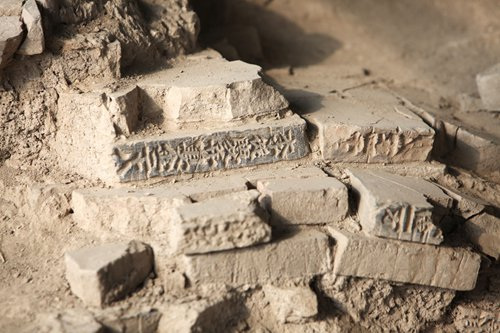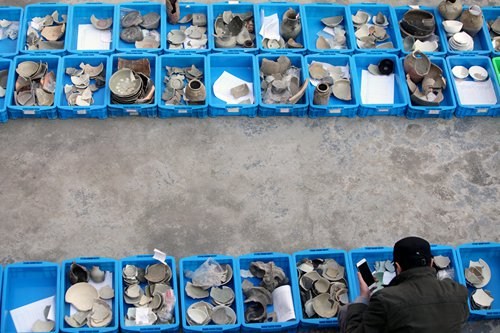

Archeological staff excavate and examine unearthed relics at the Qinglong site. More than 6,000 pieces of intact and recoverable ceramic wares and over 100,000 pieces of broken ceramics have been discovered at the site so far. (Photos: Yang Hui/GT)
More than 6,000 pieces of intact and recoverable ceramic wares and over 100,000 pieces of broken ceramics discovered at a historical site in Qinglong town of Shanghai's Qingpu district were proven by experts to have been made by kilns in Zhejiang and Jiangxi provinces sometime between the Tang (618-907) and Song (960-1279) dynasties, then transported up to Qinglong prior to their export to Japan and South Korea, Shanghai Museum recently announced.
"Ceramics are durable goods. Such a great amount of ceramics unearthed here obviously were beyond the local consumption capability, so most were intended to be shipped to other regions," said Chen Jie, director of the archeological research department in Shanghai Museum, which has conducted thorough exploration and excavation at the site over the past six years.
Those unearthed relics, together with historical books, prove that Qinglong was a major port along the maritime Silk Road. The town was established during the Tianbao reign (742-55) of Tang Xuanzong, according to historical documents.
Mi Fu, a famed Northern Song Dynasty (960-1127) painter, once served as governor of Qinglong, while the Northern Song poet Mei Yaochen once wrote that the town had "three pavilions, seven pagodas, 13 temples, 22 bridges and 36 major residential compounds."
The archeological site is spread along the banks of Tongbotang River. An archeological team from Shanghai Museum unearthed relics of housing foundations, water wells, a cooking stove and an iron-casting workshop.
A pagoda of Longping Temple, built during the Tiansheng reign (1023-32) of Song Renzong, was discovered in 2015 and has provided significant material about Qinglong town's infrastructural planning and architecture.
The pagoda's base is an octagonal structure of bricks and stones. Beneath the base, an underground vault measuring 1.48 meters long, 1.2 meters wide and 1.42 meters high was found. In it were tens of thousands of coins and a set of four boxes of decreasing size inside another.
The four boxes, from the outer to the inner, were made of wood, iron, wood mounted with gold and silver. Inside the boxes, archeologists found a Buddha statue, gems, crystal beads and four balls, most likely Buddhist bone relics.


















































